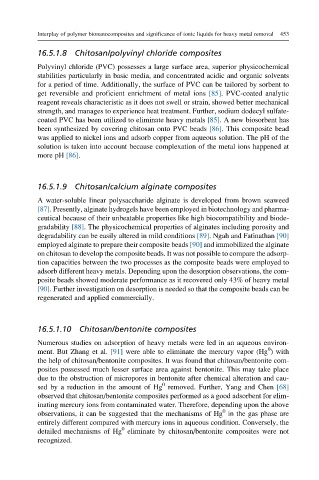Page 500 - Polymer-based Nanocomposites for Energy and Environmental Applications
P. 500
Interplay of polymer bionanocomposites and significance of ionic liquids for heavy metal removal 453
16.5.1.8 Chitosan/polyvinyl chloride composites
Polyvinyl chloride (PVC) possesses a large surface area, superior physicochemical
stabilities particularly in basic media, and concentrated acidic and organic solvents
for a period of time. Additionally, the surface of PVC can be tailored by sorbent to
get reversible and proficient enrichment of metal ions [85]. PVC-coated analytic
reagent reveals characteristic as it does not swell or strain, showed better mechanical
strength, and manages to experience heat treatment. Further, sodium dodecyl sulfate-
coated PVC has been utilized to eliminate heavy metals [85]. A new biosorbent has
been synthesized by covering chitosan onto PVC beads [86]. This composite bead
was applied to nickel ions and adsorb copper from aqueous solution. The pH of the
solution is taken into account because complexation of the metal ions happened at
more pH [86].
16.5.1.9 Chitosan/calcium alginate composites
A water-soluble linear polysaccharide alginate is developed from brown seaweed
[87]. Presently, alginate hydrogels have been employed in biotechnology and pharma-
ceutical because of their unbeatable properties like high biocompatibility and biode-
gradability [88]. The physicochemical properties of alginates including porosity and
degradability can be easily altered in mild conditions [89]. Ngah and Fatinathan [90]
employed alginate to prepare their composite beads [90] and immobilized the alginate
on chitosan to develop the composite beads. It was not possible to compare the adsorp-
tion capacities between the two processes as the composite beads were employed to
adsorb different heavy metals. Depending upon the desorption observations, the com-
posite beads showed moderate performance as it recovered only 43% of heavy metal
[90]. Further investigation on desorption is needed so that the composite beads can be
regenerated and applied commercially.
16.5.1.10 Chitosan/bentonite composites
Numerous studies on adsorption of heavy metals were led in an aqueous environ-
0
ment. But Zhang et al. [91] were able to eliminate the mercury vapor (Hg ) with
the help of chitosan/bentonite composites. It was found that chitosan/bentonite com-
posites possessed much lesser surface area against bentonite. This may take place
due to the obstruction of micropores in bentonite after chemical alteration and cau-
0
sed by a reduction in the amount of Hg removed. Further, Yang and Chen [68]
observed that chitosan/bentonite composites performed as a good adsorbent for elim-
inating mercury ions from contaminated water. Therefore, depending upon the above
0
observations, it can be suggested that the mechanisms of Hg in the gas phase are
entirely different compared with mercury ions in aqueous condition. Conversely, the
0
detailed mechanisms of Hg eliminate by chitosan/bentonite composites were not
recognized.

